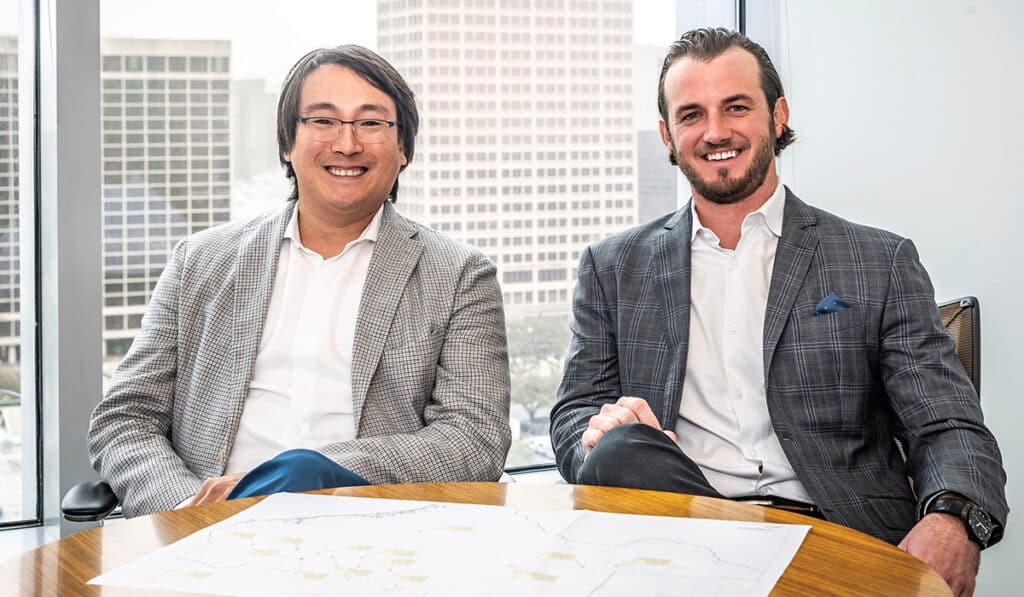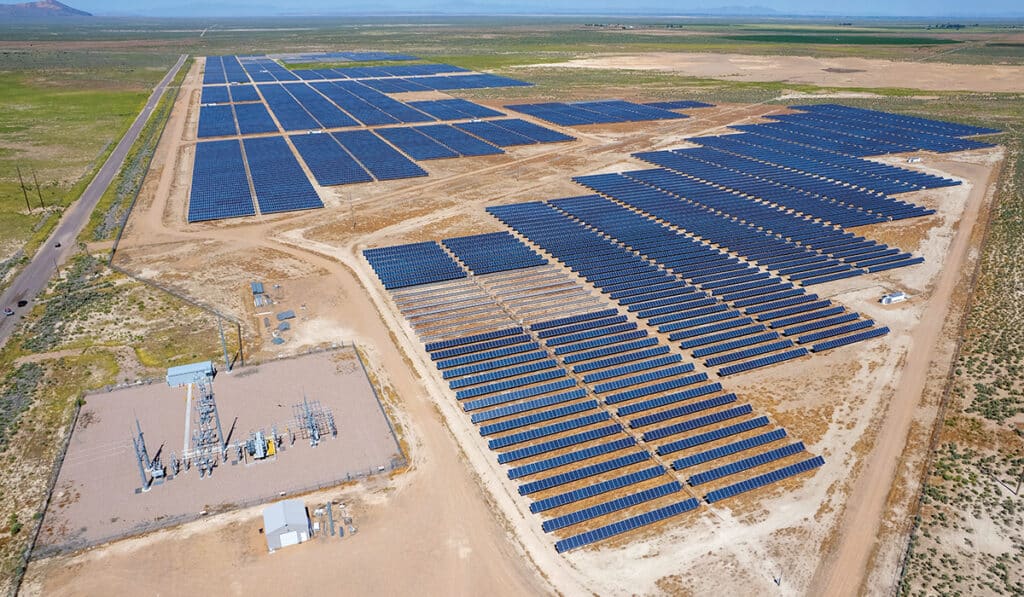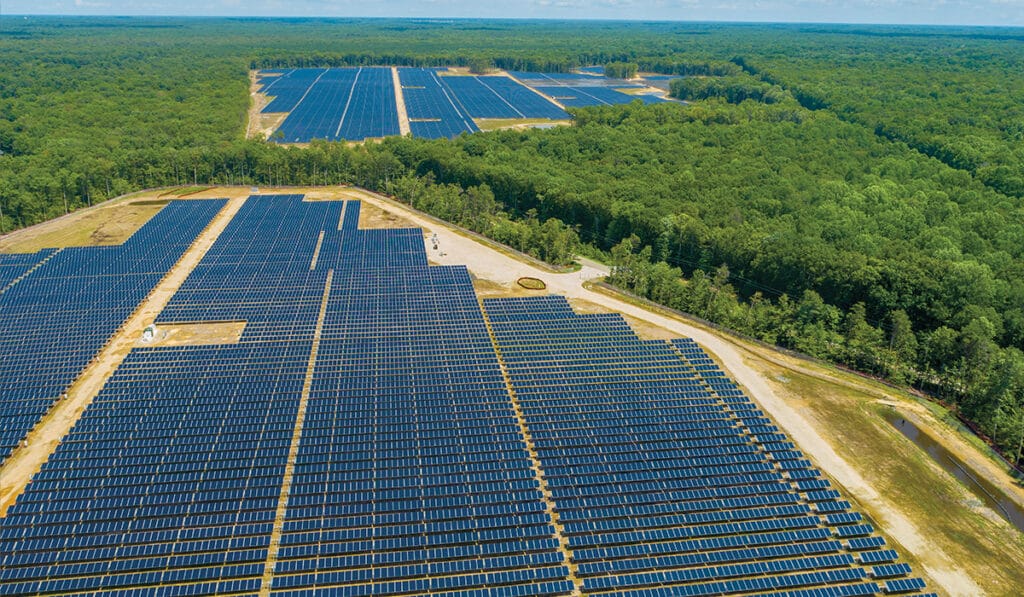
This article is featured in the Fall 2023 issue of LAND magazine. Click here to find out more.
Renewa, a forward-looking investment firm based in Houston, operates at the rapidly growing intersection of renewable energy and real estate.
Renewa, a forward-looking investment firm based in Houston, operates at the rapidly growing intersection of renewable energy and real estate.

We’re a real estate company that buys land under renewable projects,” said the company’s co-founder and co-CEO Gage Mooring. “We also purchase full or partial assignments of the leases or revenue from long-term solar and wind leases.”
In both cases, Renewa provides landowners, whose land and/or lease fits the company’s goals, lump sum payments for their assets. According to Mooring, lump sum payments offer landowners several benefits.
First, an immediate cash payout can reduce the risks posed by changing interest rates and inflation by allowing landowners to reinvest the money into different asset classes that might have higher returns than their remaining lease payments. Second, landowners who choose to sell an interest in their land as well as their lease and/or royalties, are often eligible to defer taxes from the sale through 1031 exchanges. Third, landowners who sell their land, rental or royalty income, may also have the option to lower their property tax exposure by paying long-term capital gains taxes (15-20 percent) instead of ordinary income tax (37 percent), which is typically how rental and royalty income tax is applied.
In addition, cash is often easier to distribute as part of an estate than property, so estate planning might be simplified. Finally, renewable energy leases do not guarantee that the operator will stay in business or continue paying royalties.
“When Renewa purchases someone’s land and/or their rent or royalty payments, we assume the risks that go along with the uncertainty that is inherently part of the future,” Mooring said.
Renewa is backed by long-term pension capital, which allows the company to fund projects decisively while taking a long-term position in the renewable energy sector.
“By design, pension funds, unlike private equity, takes a 40-year view, which means that we do, too,” Mooring said. “Our business model is to buy and hold assets for the duration of the lease, so we’re the opposite of ‘fly by night flippers,’ who are in the business to buy and resell these interests for a quick gain.”
While Renewa prides itself on being in the industry—and in communities—for the long haul, the team negotiates and responds nimbly. In most cases, the company can value a property quickly and typically close a transaction within 45 days.
“Because we’ve earned the responsibility of investing pension capital, we have the ability to deliver on our promises,” Mooring said. “We do what we say we’re going to do—and once we agree on terms they don’t change. That is why we enjoy a 90 percent close rate and get a lot of our business from landowner referrals.”
On the Ground
To help demonstrate its product offering, Renewa often uses the following basic transaction example. A landowner is owed rent/royalty payments of $100,000 per year with 25 years remaining on the lease term. Renewa pays seller $1.25 million today for the lease rights.
The landowner benefits from a large payout today, which they can use to achieve their financial goals, whether that be to invest in their business, pay down debt, facilitate estate planning, or save for the future. Renewa, in turn, benefits from receiving the long-term payments which align with their investment objectives over the long-term.

The business model works because unlike oil and gas, renewable energy is not priced like a commodity.
“Oil and gas are notorious for their ups and downs, but renewables are fairly stable,” said Mooring, noting the renewable industry is heavily incentivized and the long-term leases have defined payments. “While oil and gas are not going anywhere soon, the green energy transition will happen in our lifetime, and our team wants to be in a position to effectuate change.”
In the instances where the Renewa team purchases land along with a lease or royalties, their business model is reinforced by the value of the underlying land. It is a tangible asset which value has steadily increased over time.
Plus, solar energy and wind energy have large footprints and require a lot of land, so demand will likely remain high. According to an article in Bloomberg News, wind farms, solar installations and other forms of clean power take up far more space on a per-watt basis than their fossil-fuel-burning brethren. A 200-megawatt wind farm, for instance, might require spreading turbines over 19 square miles (49 square kilometers). A natural gas power plant with that same generating capacity could fit onto a single city block.
President Joe Biden, speaking at an international climate summit in March 2021, vowed to cut U.S. greenhouse gas emissions in half by 2030. Achieving Biden’s goal will require aggressively building more wind and solar farms along with battery storage units and transmission lines.
“One of the hurdles is renewable energy development is increasing our ability to transfer electricity from the rural areas where it’s produced to the urban and suburban areas where it’s consumed,” Mooring said. “A second challenge is storage capacity. Renewables are most productive during the middle of the day, but Americans consume the most energy early in the morning and at night when we’re at home.”
To fulfill the President’s vision of an emission-free grid by 2035, the U.S. needs to increase its carbon-free capacity by at least 150 percent. According to estimates by Bloomberg and Princeton University, expanding wind and solar by 10 percent annually until 2030 would require a land mass equal to the size of South Dakota. By 2050, when Biden wants the entire economy to be carbon free, and the U.S. will need up to four additional South Dakotas or almost 250 million acres to develop enough clean power to run all the electric vehicles, factories and meet all other demands.
Renewable energy has been expanding across the country steadily, with Texas and California leading the way. Initially, wind energy made its mark, but in the aftermath of the Inflation Reduction Act, which contained $370 billion earmarked for renewable energy investment, the solar industry has grown exponentially. In fact, in the past two years, Renewa has seen its portfolio shift from 60 percent wind and 40 percent solar to 60 percent solar and 40 percent wind.

“For us, it’s less about the mix of energy sources and more about a geographic mix of energy production,” said Mooring, noting Renewa is active in the lower 48 states.
Regardless of where the transactions take place, they are built on relationships. Jonathan “JR” Rich, a former oil and gas landman who is now Vice President of Land for Renewa, traverses the country knocking on doors, educating landowners and having conversations on the company’s behalf.
“The thing we appreciate most is the relationships that we’re developing with landowners across America,” Rich said. “This is all new and a big part of my job is simply educating landowners about the renewable industry and their options.”
A solid reputation built on earned trust is the foundation for the company’s success now and in the future. As a result, the team believes in transparency.
“In rural America, good reputations are made by shooting straight, dealing straight and being reliable,” Rich said. “Being a first mover in an emerging space, we are bound to make some mistakes, but we don’t hide them. Instead, we learn from them and then share what we learn.”
When the Renewa team enters an area, they are the new kids on the block. As such, they develop key relationships and then rely on word-of-mouth to prompt others to roll out their welcome mats.
“It helps spread the word exponentially when influencers are speaking on your behalf, which makes strong relationships part of our competitive advantage,” Rich said. “The most successful renewable projects are those that have widespread community support.”
He continued, “My best advice for anyone considering renewables is, ‘If in doubt, talk to other people who are involved.’ In this rapidly emerging space, there are plenty of good questions to be asked that deserve answers. At Renewa, we’re here to help.”
Some Things to Consider Before Signing a Lease

- Maintain an option to sell your land or to reassign the payments.
- Evaluate payment escalation schedule; the best leases are those that are most closely tied to increases in the Consumer Price Index.
- Negotiate to keep the development and construction phases as short as possible in order to enjoy a longer period of production, which is generally more valuable.
- Include provisions that guarantee payment for the loss of the use of any land or infrastructure such as irrigation pivots that are “stranded” or made inaccessible by the siting of the project.
- In the case of royalty payments, push to have the minimum guaranteed payment be as high as possible as opposed to opting for higher “royalty” payments that promise a certain percentage of profit; the minimum payment is “bird in the hand” money.
- Negotiate with the energy production company to cover the property taxes. Because solar farms and wind farms are considered industrial uses in most states, they can nullify agricultural tax valuation and cause the tax bill to soar. The best scenario for landowners is triple net where the energy production company agrees to pay the tax bill in its entirety; the second-best scenario is double net where the energy production company agrees to pay the difference between the agricultural valuation and the new higher commercial/industrial/market rate.
- Ensure the lease requires complete remediation at the energy company’s expense once the project is decommissioned and take into consideration the long-term impacts of inflation on the amount of money the company is putting down as bond to fund the cleanup.
